The Last Stand of the Last Great Wilderness
The Arctic National Wildlife Refuge is in jeopardy as never before
Photos by Kiliii Yüyan
THE LONGEST DAY OF THE YEAR means nothing in the Arctic. All the midsummer days are so long that they blend together into a single, seemingly endless day—a day that lasts for weeks as the sun nods at the horizon but never slips below it, never allowing the demarcation of darkness.
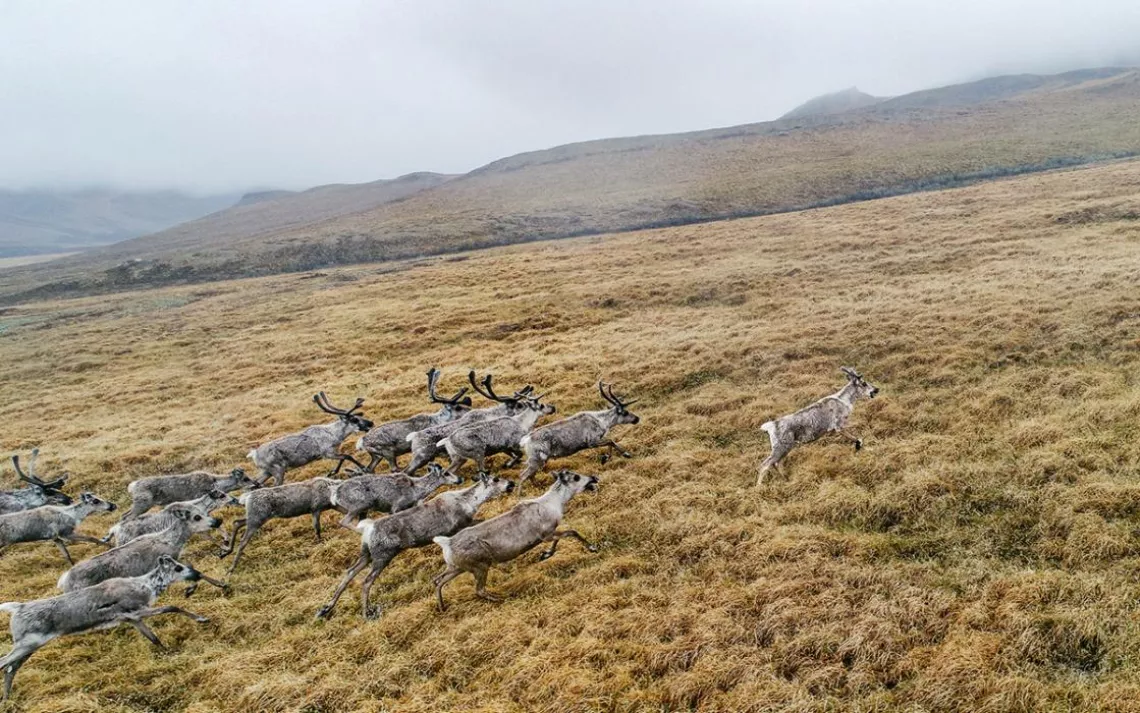
But people bring their own orientations of time and place with them, and so we knew, as we hiked over a tussocky tundra painted gold in the slanting light of two in the morning, that we were in the early hours of the solstice. We'd climbed to a high ridge to get our bearings within the enormous landscapes of the Arctic National Wildlife Refuge: to the south, the Brooks Range, toothy and snowy and seemingly endless; to the north, the vast, soggy flatness of the coastal plain, where the shine of water and ice disappeared into the glow of that hovering sun. We had seen below us the small cluster of our tents on the edge of a braided gray river, the Hulahula, which was to be our passageway from the mountains, through the wide tundra, to the Arctic Ocean.
On our way back to camp, we stopped on a small rise above the river valley, wanting time with the view more than we wanted sleep. I had already come to think of such places as "wolf hills," for it seemed that whatever high places I wanted to climb also appealed to other watchers, which left behind antlers riddled with chew marks and scat dense with caribou fur.
It was Wyatt, one of our guides—you could tell he'd grown up in Alaska by his bare hands in the bitter weather—who spotted the bear swimming across the river below us. It was a grizzly, the third we'd seen in as many days. We watched as it lumbered through the low willows along the river's edge, pausing occasionally to dig or sniff. Then it halted and stared up at the four creatures on the wolf hill.
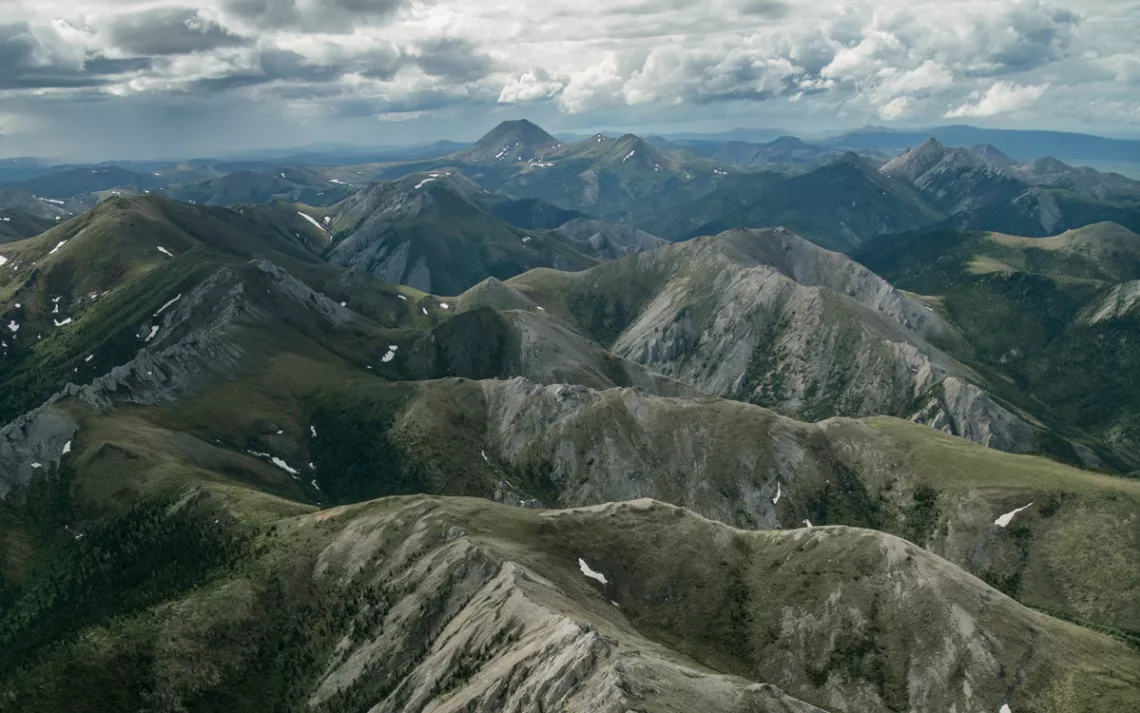
The Brooks Range stretches east to west, a continental divide that splits the watersheds of the Pacific and Arctic Oceans.
What happened next was told repeatedly over the following few days, though each of us had different tellings. Those of us on the hill saw the bear move steadily and deliberately closer, and closer and closer still, until finally it was near enough, just at the bottom of our suddenly insignificant little rise, that our hearts pounded wildly—though not quite so near that anyone unholstered their bear spray. Then, breaking into a moment's run, the bear turned so that its path was no longer toward us but narrowly past: a message we took as defiance rather than aggression. But for those in camp watching the scene through binoculars, who couldn't perceive the shift in direction, the bear seemed to be heading straight toward their companions on the hill as it broke into a full charge. In a moment of pure panic, someone yelled about firing the emergency shotgun—toward us as well as the far-too-distant-for-that-idea-to-work bear. When we arrived back in camp, all the laughter and adrenaline called for a second round of hot drinks and cookies (as many things do when you are cold all the time).
When I thought about the episode later, the totally contradictory ways we experienced the bear encounter seemed appropriate to the place. To a new arrival, the Arctic in summer is pure confusion, a set of realities that seem to always shift and conflict. You can't tell the time or your place in it because of the endless days; you completely forget to be tired, or hungry, or hurried. Distance and size, too, become mysteries: Without trees for scale, hills that seem close take hours to reach. Plants that you usually think of as trees max out at only a few inches high, while tiny lichens grow in mats so thick they bounce like pillows. Whole herds of caribou, hundreds or thousands of enormous animals, can disappear in a few minutes, swallowed up by a far more enormous landscape. In the flat plains, the horizon blurs in and out, as though reality is getting poor reception.
The Arctic National Wildlife Refuge holds Alaska's single-most-remote spot, the very farthest you can get from human roads, trails, or homes. A bush plane bringing travelers will fly over hours of uninterrupted wilderness (a fact that guides implore you to think long and hard about before climbing that boulder or fording that stream or messing around with that pocketknife) and land on "airstrips" that are simply areas of flattish tundra or gravel bars cleared of large rocks and sometimes marked with caribou antlers. And yet it is far from isolated. You'll come around a bend in the river and see, in a strange new landscape, familiar old friends on summer vacation: geese and mallards and swans, falcons and thrushes and sparrows and sandpipers, each a reminder that the refuge is directly linked by avian migration to every U.S. state and every continent but Australia.
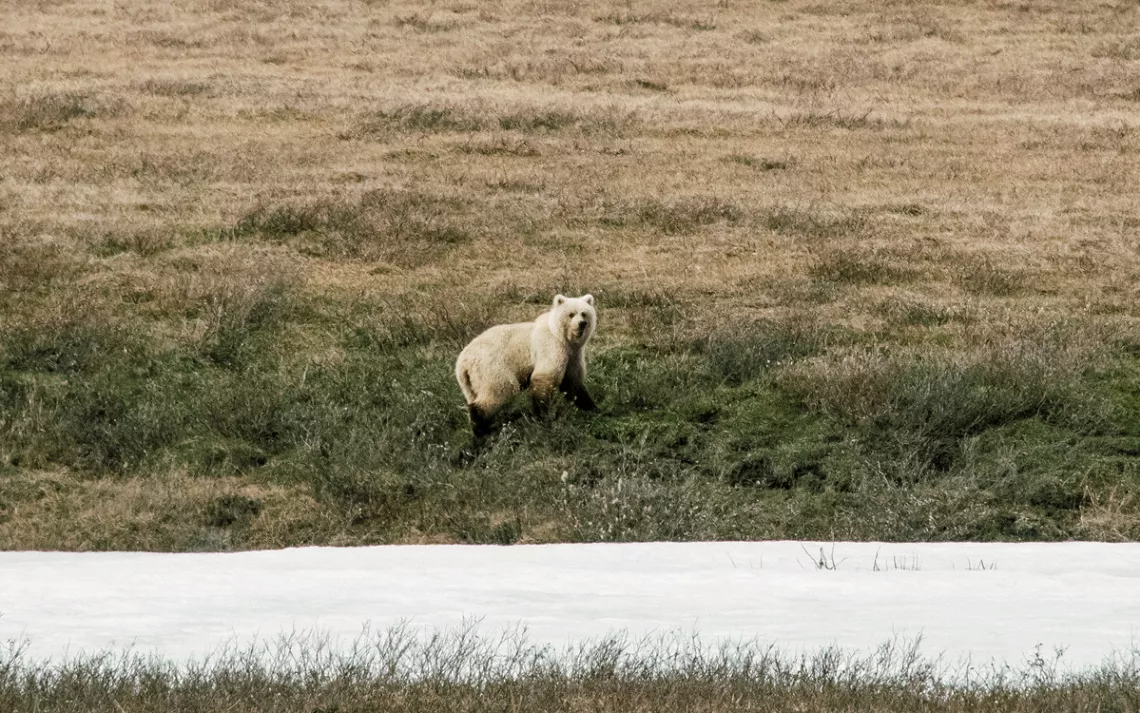
Grizzly bears thrive in the Arctic Refuge; the group encountered three in as many days.
Though the Arctic may be far from factories and traffic jams and other major sources of carbon pollution, human-driven climate change is warming it faster—as much as two times faster—than anywhere else on Earth. The signs are everywhere: melting permafrost that makes ponds and wetlands drain and hillsides collapse; disappearing sea ice that leaves polar bears starving and new shipping lanes open; animals and plants whose ranges are moving northward. Some of the changes, such as the increase in dark, heat-trapping open water and the release of methane once locked in permafrost, also act as accelerators of change that will lead to even more change and even more warming. When it comes to the planetary-scale transformations of climate change, isolation doesn't exist. Not even here.
Remoteness is an illusion in other ways as well. To most of the country, ANWR means filibusters and lobbyists at least as much as it does caribou and bears; it is not a refuge but an acronym, one meant to make a living landscape anonymous. The decisions that guide the future of this area are consistently made far away, often by people who have never seen it. Those decisions have generally had more to do with competing visions of the Arctic wilderness—what it symbolizes about our nation, what we value, who we are—than with the place itself.
After meeting the grizzly, our small group of travelers went to sleep with a bright sun shining through our tents, but woke up to find all perspective replaced by a thick, cold fog. This, too, seemed fitting: It was the day that the river would carry us into the most contested part of the Arctic National Wildlife Refuge, the section that has existed in a murky limbo of competing futures and alternative realities for decades, ever since a protected wilderness became a target for oil development. At who-knew-what-time, who-knew-where in that strange and staggering landscape, we strapped our baggage to our rafts and pushed them into the swift water, pointed toward a still-blurry horizon.
THE MODERN STORY of the Arctic Refuge—the story not of an ancient place and its rhythms and relationships but of an embattled landscape with a mythic role in the American consciousness—could begin in a number of places, but often the telling starts in 1929. A 28-year-old forester named Bob Marshall, a New Yorker who had dreamed for many years of being an explorer in the Lewis and Clark mold, decided to spend his summer vacation "in what seemed on the map to be the most unknown section of Alaska." He traveled to the central region of the Brooks Range—the great wall of mountains that stretches 700 miles from east to west across northern Alaska, a continental divide splitting the watersheds of the North Pacific and the Arctic—and was so impressed by the grandeur and the adventure and the lives of the local Indigenous people ("unknown" was an outsider's misimpression) that he returned again and again. Years later, when the U.S. Forest Service asked him to make recommendations about tourism and recreation in Alaska, Marshall had a surprising response, far beyond what had been asked of him. Arctic Alaska, he wrote, should not be developed at all. The future of the country depended on it.
"Never before," writes Alaskan historian Roger Kaye, "had wilderness—or any conservation designation—been seriously proposed on such a grand scale." There was the young National Park Service, of course, and other wildlife refuges, but Marshall wasn't thinking about visitor enjoyment or game management. He believed that the Alaskan Arctic carried a significance far bigger than itself, as a national last chance at the sort of wilderness that had shaped America. The country was still in the midst of an identity crisis sparked by the historian Frederick Jackson Turner, who believed that the national character, even American democracy itself, was the product of societies forming along a westward-moving frontier. In an influential essay published in 1893, Turner wrote, "This perennial rebirth, this fluidity of American life, this expansion westward with its new opportunities, its continuous touch with the simplicity of primitive society, furnish the forces dominating American character." According to the U.S. Census Bureau, that formative frontier had, by 1890, officially closed.
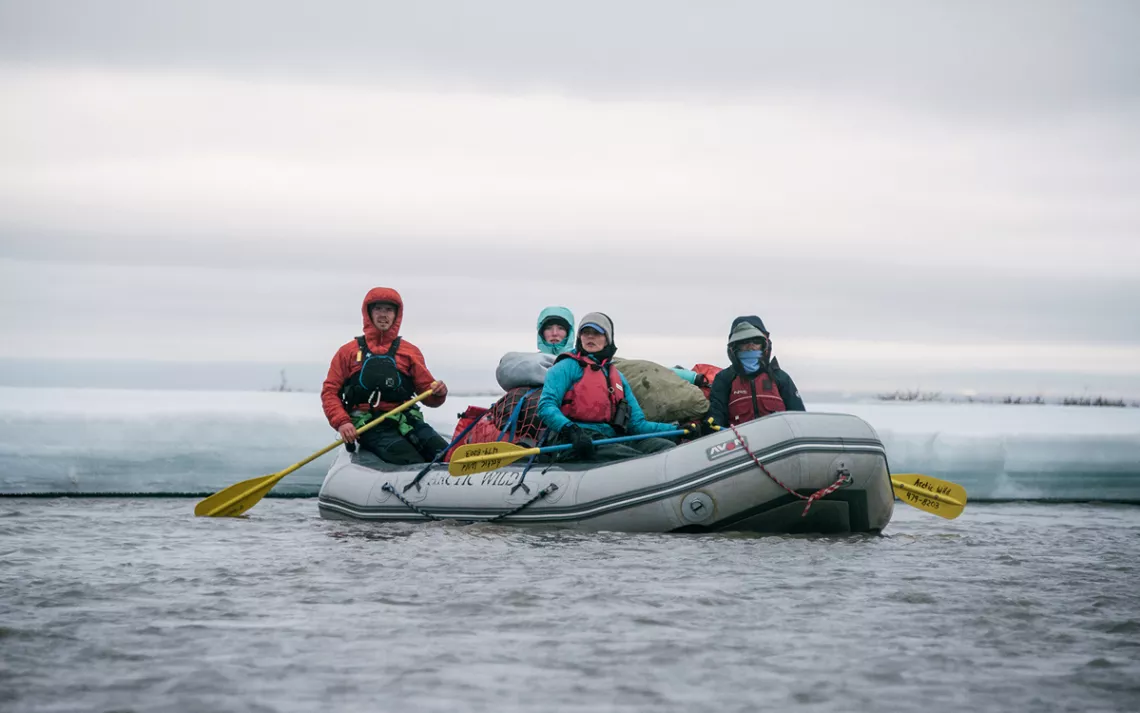
The group floated the Hulahula from the Brooks Range to the Beaufort Sea.
Marshall saw the enormous, largely unsettled Arctic lands he had explored as a possible antidote to this—not another chance to keep chasing America's so-called Manifest Destiny but a chance to finally stop chasing it. Even people who would never see the Alaskan Arctic, he believed, would benefit simply from knowing that it still existed in the condition it always had. "In Alaska alone," he wrote, "can the emotional values of the frontier be preserved."
Marshall's arguments, and the responses they elicited, would echo again and again in a dispute that would continue for the next 80 years, their contours becoming more familiar with the decades. There were people who thought that Marshall was thinking too large and that compromising from the start with a less ambitious goal would be wiser. There were those who said the refuge idea was a land grab and a "stranglehold on progress" and who resented "any outside organization that pokes its nose in Alaska's affairs."
And there were others who found themselves stirred by a big idea: In a changing world, saving wildness could be a way of saving something fundamental about themselves. In 1953, a biologist and a planner for the National Park Service, George L. Collins and Lowell Sumner, published an article in the Sierra Club Bulletin titled "Northeast Arctic: The Last Great Wilderness." The land was once again a last chance at redemption through preservation, but now the vision for its future, influenced by the work of Aldo Leopold, was more of an ecological one. "For the future needs of Alaska and the entire nation, this superb area should be planned and dedicated now for perpetual preservation as a scientific field laboratory," they wrote. In the booming postwar era, some Americans were feeling disoriented by enormous changes—a baby boom, pollution, the transformation of natural spaces into industrial and residential ones—that foreshadowed a future of degraded environments. A reserve in the Arctic could be more than a static museum of a romantic, awe-inspiring landscape. It could be the control to the dramatic and worrying experiment in development that was rapidly altering the rest of the country, a place where large and intact natural systems could work uninhibited, a touchstone to remind us of where we came from and what the world could be without us.
"The concept of 'primeval,'" Kaye writes, "began to convey the emerging understanding that it was dynamic evolutionary and ecological processes, more than landscape features, that were timeless." The authors of the Bulletin article included a sketch of the Porcupine caribou herd, whose calving grounds are in the coastal plain of the refuge: caribou pouring down a gorge by the thousands, a river of animals that recalled the guilt of what America had done to the epic bison herds of the Great Plains. The "Arctic prairie," as the authors termed it, offered a chance to do better—to encounter a "frontier" without dominating or destroying the people and the wildlife that were already there.
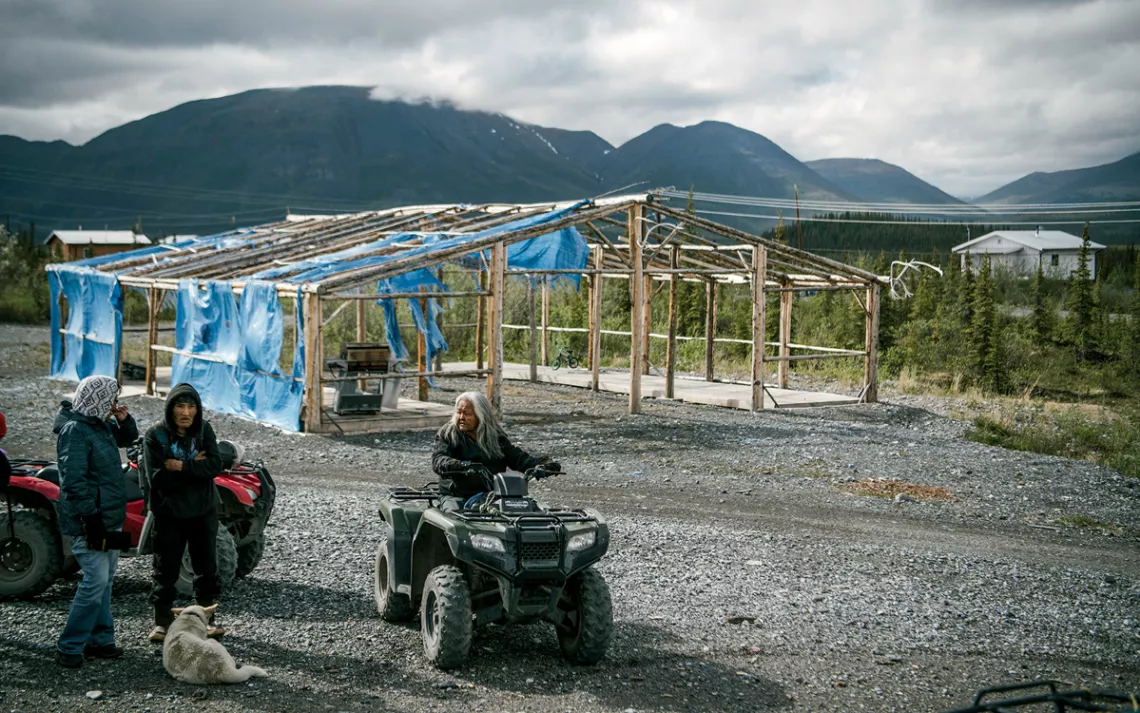
The Gwich'in residents of Arctic Village have led the fight against oil drilling in the region.
In 1960, President Dwight D. Eisenhower protected nearly 9 million acres as the Arctic National Wildlife Range, later to be expanded and renamed a national refuge. Wilderness proponents celebrated—"Surely there should be a few such places on this plundered planet!" wrote Mardy Murie, one of the lead campaigners. But they also worried that the designation was not strong enough. Eight years later, oil deposits were discovered on the Brooks Range's North Slope, to the west of the protected prairie. (Proponents of the Arctic Range, to help make their cause more palatable, had not pushed to include the area they knew was of interest to oil developers, but now it seemed the entire North Slope was of interest.) The old debate over the meaning of frontiers resurfaced. Sure, the idea of keeping one last one was nice, but that was never how America had treated the frontiers of the past; frontiers, by American definition, were for developing. A portion of the "last great wilderness"—the same prairie that supports the caribou during calving season—would be evaluated for its oil and gas development potential.
The fight over whether to permit drilling would continue for nearly four decades. It would dominate headlines and political campaigns. Sometimes the refuge would be on the verge of drilling and other times on the edge of more meaningful, lasting protection. Drilling would be thwarted by Senate filibusters, the Exxon Valdez spill, a presidential veto. The meaning of the refuge would shift—a last chance for wilderness or a last chance for energy independence, a vital habitat in need of protection or a barren wasteland in need of purpose—but it would always be understood to be a referendum on who we are and what we value as a nation.
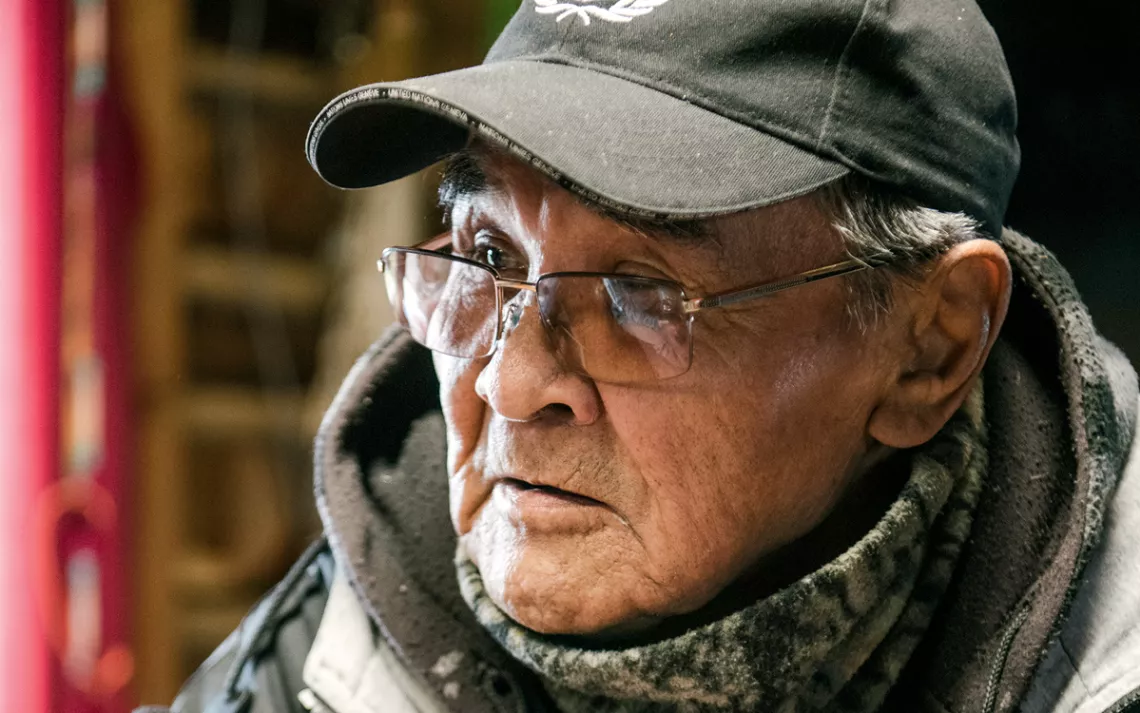
Gwich'in elder Gideon James says his people live "in a real fashion."
And then last December, in the midst of a chaotic administration, a historically unpopular president signed a major tax bill with a largely overlooked rider. Just like that, after almost 50 years of passionate debate, U.S. law would require oil leasing on the Arctic prairie.
JUST ACROSS THE CHANDALAR RIVER from the southern edge of the refuge is Arctic Village, also called Vashraii K'oo, a Gwich'in community of small, bright houses scattered about a landscape of turquoise lakes and black spruces. It's been a permanent settlement for a little over a century, but Gwich'in people have lived in the area, moving with the seasons, hunting caribou and other game, for far longer. Archaeological evidence suggests they've been here at least thousands of years; Gwich'in traditional knowledge says, simply, since the beginning.
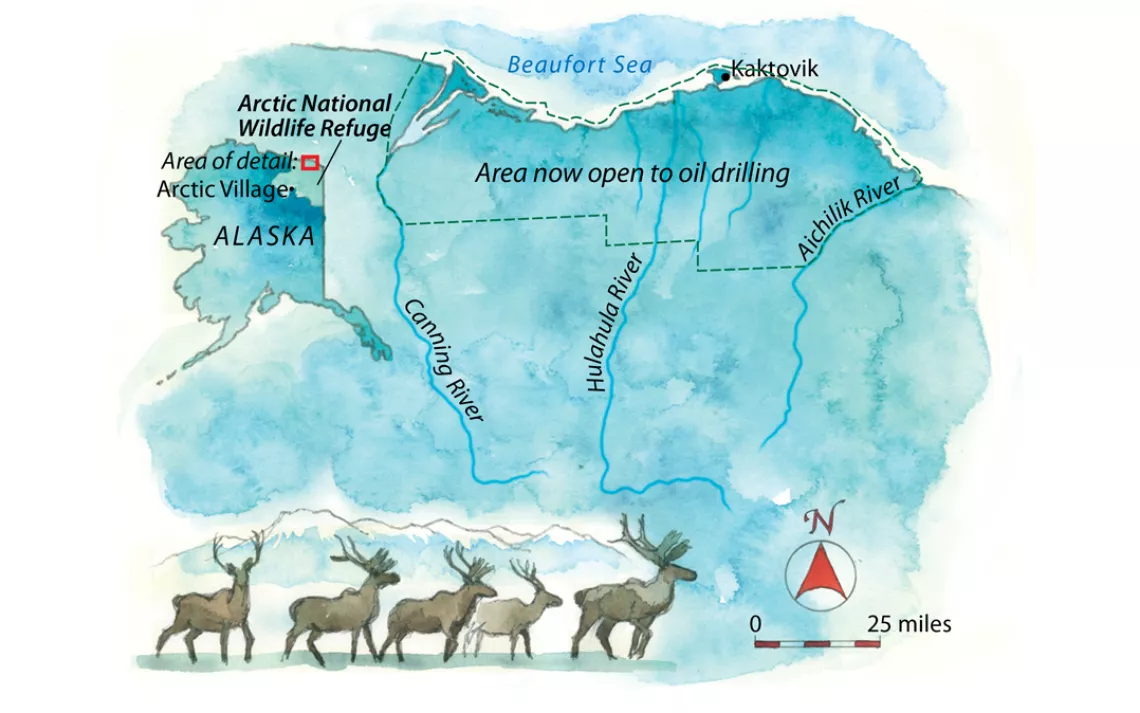
Map by Steve Stankiewicz
In June, as we traveled north to the refuge, the village buzzed with mosquitoes and with the four-wheelers that are the favored mode of summer transport. Ice fishing and the spring bull caribou hunt and duck season were all over. People zipped off to swim and fish in the cold lakes, to cut wood, to play with their kids in the endless light before the caribou, fattened up for winter, passed by again. In a sign of the frenzied joy of the short Arctic summer, Daniel Tritt, Nina John, and their four young kids all showed up for an interview one night at 11:30 P.M. While I (still on a different latitude) was climbing into my sleeping bag, the family was thinking about making popcorn and watching a movie.
Born in a Fairbanks hospital, Tritt had lived in Arctic Village since the -40°F November day that his grandmother had stuffed the new baby inside her parka to bring him off the plane. Now 33, he was teaching his children the same things he learned when he was a child. Last year, his 11-year-old son shot his first caribou. Following the tradition of the first kill, his son gave most of the meat away to others in the village, especially elders who no longer hunt. The next oldest, now 10, was hoping that this year would bring his turn. Even the very youngest had gone along on hunts. Tritt laughed and said that his two-year-old daughter rubbed her hands together whenever she saw raw cuts of caribou meat, which she called "candy."
The Gwich'in sometimes call themselves the "caribou people" and the coastal plain of the Arctic Refuge "the sacred place where life begins." Everyone I met in Arctic Village stressed how important the animals are—how many parts of the caribou's bodies they make use of, how much they rely on them, especially when other food is so expensive (the local store offers a half gallon of apple juice for $9.45), and how much they fear that something could happen to the caribou and change their lives forever. "My people have lived in a real fashion, where they know how to do things for themselves; they're skillful," a 78-year-old tribal elder named Gideon James told me. "For the life of me, I'm ashamed of the legislators. All they are is a puppet of the big companies."
In 1988, James helped construct the wooden building that the village now uses as a community center (the logs, noticeably larger than the local skinny black spruces, were skidded in from distant creeks). Then, the building was a hall made specifically to house a gathering of Gwich'in elders, who came in from villages across Alaska and northwestern Canada, all places that depended on the caribou. Together, they decided to oppose drilling in the Arctic National Wildlife Refuge, a commitment that they have upheld at every gathering since.
In a video of the meeting, a young Daniel Tritt is visible, running around and giggling in the same hall his sons were running and giggling in while I interviewed him. The fight has gone on so long, it has become generational. (Two months after our visit, Tritt was killed in a four-wheeler accident. "The day before his passing, he went hunting and brought six caribou back to the village," his obituary stated. "He will be missed for his kind heart, genuine smile, and generous ways.")
The day after I met Tritt, James enlisted volunteer help to re-ink the names on a wooden monument that he'd made to honor the elders present at the 1988 meeting. He had named the area Hero's Park and decorated the monument with a logo: a quartered circle with the prints of a bear, a wolf, a caribou, and a child. "It's an ongoing thing here, constantly," said Mabeleen Christian, a member of the village council, as we watched the volunteers. In the summer of 2017, with the threat to the refuge accelerating—"everybody knew, as soon as Trump was in office, we knew right then," Christian said—the Gwich'in held an emergency meeting to reaffirm their opposition. But the law changed anyway, and they found themselves in a more alarming reality.
"Me myself, I believe it's going to happen," Christian said, of drilling on the calving grounds, "but as long as I'm living, standing here, I will fight."
THE HULAHULA RIVER raced downward from the Brooks Range, the water swift and painted with the white of rapids. As it entered the flatness of the coastal plain, it spread out into more leisurely meanders and became a maze of braided channels that often left our rafts marooned in shallow water or separated them on either side of a river complex so wide and divided we could barely see across it. Around one turn, we surprised a bear, which stood on its hind legs to assess us before sprinting away. I surprised another, not to mention myself, on a bleary morning walk to the latrine. There were foxes and snowy owls and lemmings and ground squirrels. As the days passed and we moved farther north into the coastal delta, we saw more and more birds, more caribou starting a long journey with calves just weeks old. The place was a lot of things, but barren wasteland was not one of them.
It's strange to move through a landscape that is both timeless and running out of time. Even in early summer, the edges of the river were covered in walls of carved blue ice, remnants of the winter. On land, the frozen ground made our feet ache. When we had to portage from the Hulahula River to the Okpilak River, we waded through shallow ponds, created through ancient cycles of freeze and thaw that sculpted the ground into polygons, so perfectly geometric they looked like art.
Though I tried, I couldn't imagine the coastal plain sliced with roads and dotted with well pads; it was jarring enough to see a helicopter fly overhead in this place where the only human world is the one you bring with you. But when surrounded by big-box parking lots, I also can't imagine what such developed landscapes looked like—how their ecology worked, what they felt like—before they were remade in our image. Though the places are the same, their former reality has been stripped away.
The future of the refuge is still the mystery it has always been. The faraway politics, our ideals about wilderness, and, not incidentally, the prices of oil and possibly carbon are all in flux. Environmental groups and Alaska Natives like the Gwich'in have vowed to fight drilling in any way they can, but they are on the defensive as never before, with the focus moving to court battles and delays and to dissuading oil companies and banks from getting involved.
Supporters of drilling contend that the ecosystem damage would be minor. They usually don't talk about the wilderness value behind the refuge's original establishment. The Trump administration has asked for the required environmental review to be fast-tracked, demanding in months what normally takes years. Isolation has never felt so illusory.
By the time the rafts followed the river into a brackish lagoon on the edge of the Arctic Ocean, it was so cold I kept my life jacket on over two layers of long underwear and four coats. We set up our tents for the last time on a narrow gravel spit threaded with the enormous footprints of a polar bear, then beached the rafts and continued on foot to what looked like an endless expanse of shore-fast sea ice, dusted with snow and dimpled with turquoise pools of meltwater. A fat seal rested in the distance. Before I stepped onto the ice, someone asked, "Have you ever walked on the ocean before?" I laughed in surprise at the sudden reminder of the surreality I had grown used to in just one strange week.
That night, the sun took its long slide along the top of the world and then back up, coloring the sky pink and gold. By morning, the ice was too slushy to walk on. I thought of something that Olaus Murie, one of the tireless proponents of protecting the Alaskan Arctic, wrote in 1959, when he was afraid that the effort would fail. "This is a bigger question than some have assumed," he implored in a letter to one of the senators of the brand-new state. "It involves the real problem of what the human species is to do with the earth."
Though this is a question we have found ourselves answering over and over, we can't assume that we will always have another opportunity to ask it again.
This article appeared in the November/December 2018 edition with the headline "The Last Stand of the Last Great Wilderness."
Sierra Club Outings offers trips to the Brooks Range in 2019. For details, see sc.org/adventure-travel.
 The Magazine of The Sierra Club
The Magazine of The Sierra Club



